Stability and Load-Carrying Capacity of Thin-Walled FRP Composite Z-Profiles under Eccentric Compression
Abstract
:1. Introduction
2. The Object of Study
3. Experimental Methods
4. Numerical Analysis
5. Results
5.1. Composite Material Damage Initiation
5.2. Loss of The Load-Carrying Capacity–Limit States
6. Conclusions
Author Contributions
Funding
Conflicts of Interest
References
- Feo, L.; Latour, M.; Penna, R.; Rizzano, G. Pilot study on the experimental behaviour of GFRP-steel slip-critical connections. Compos. Part B Eng. 2017, 115, 209–222. [Google Scholar] [CrossRef]
- Madukauwa-David, I.D.; Drissi-Habti, M. Numerical simulation of the mechanical behaviour of a large smart composite platform under static loads. Compos. Part B Eng. 2016, 88, 19–25. [Google Scholar] [CrossRef]
- Debski, H.; Teter, A.; Kubiak, T.; Samborski, S. Local buckling, post-buckling and collapse of thin-walled channel section composite columns subjected to quasi-static compression. Compos. Struct. 2016, 136, 593–601. [Google Scholar] [CrossRef]
- Chroscielewski, J.; Miskiewicz, M.; Pyrzowski, Ł.; Sobczyk, B.; Wilde, K. A novel sandwich footbridge—Practical application of laminated composites in bridge design and in situ measurements of static response. Compos. Part B Eng. 2017, 126, 153–161. [Google Scholar] [CrossRef]
- Ferdynus, M.; Kotełko, M.; Urbaniak, M. Crashworthiness performance of thin-walled prismatic tubes with corner dents under axial impact—Numerical and experimental study. Thin Walled Struct. 2019, 144, 106239. [Google Scholar] [CrossRef]
- Kubiak, T.; Kolakowski, Z.; Swiniarski, J.; Urbaniak, M.; Gliszczynski, A. Local buckling and post-buckling of composite channel-section beams e numerical and experimental investigations. Compos. Part B Eng. 2016, 91, 176–188. [Google Scholar] [CrossRef]
- Fascetti, A.; Feo, L.; Nistico, N.; Penna, R. Web-flange behaviour of pultruded GFRP I-beams: A lattice model for the interpretation of experimental results. Compos. Part B Eng. 2016, 100, 257–269. [Google Scholar] [CrossRef]
- Banat, D.; Mania, R.J. Failure assessment of thin-walled FML profiles during buckling and post buckling response. Compos. Part B Eng. 2017, 112, 278–289. [Google Scholar] [CrossRef]
- Berardi, V.P.; Perrella, M.; Feo, L.; Cricri, G. Creep behavior of GFRP laminates and their phases: Experimental investigation and analytical modelling. Compos. Part B Eng. 2017, 122, 136–144. [Google Scholar] [CrossRef]
- Kubiak, T.; Samborski, S.; Teter, A. Experimental investigation of failure process in compressed channel-section GFRP laminate columns assisted with the acoustic emission method. Compos. Struct. 2015, 133, 921–929. [Google Scholar] [CrossRef]
- Samborski, S. Numerical analysis of the DCB test configuration applicability to mechanically coupled fiber reinforced laminated composite beams. Compos. Struct. 2016, 152, 477–487. [Google Scholar] [CrossRef]
- Samborski, S. Analysis of the end-notched flexure test configuration applicability for mechanically coupled fiber reinforced composite laminates. Compos. Struct. 2017, 163, 342–349. [Google Scholar] [CrossRef]
- Samborski, S. Prediction of delamination front’s advancement direction in the CFRP laminates with mechanical couplings subjected to different fracture toughness tests. Compos. Struct. 2018, 202, 643–650. [Google Scholar] [CrossRef]
- Gliszczynski, A.; Samborski, S.; Wiacek, N.; Rzeczkowski, J. Mode I interlaminar fracture of glass/epoxy unidirectional laminates. Part II: Numerical analysis. Materials 2019, 12, 1604. [Google Scholar] [CrossRef] [PubMed] [Green Version]
- Samborski, S.; Gliszczynski, A.; Rzeczkowski, J.; Wiacek, N. Mode I interlaminar fracture of glass/epoxy unidirectional laminates. Part I: Experimental studies. Materials 2019, 12, 1607. [Google Scholar] [CrossRef] [PubMed] [Green Version]
- Samborski, S.; Rzeczkowski, J. Numerical modeling and experimental testing of the DCB laminated composite beams with mechanical couplings. In Proceedings of the 22 International Conference on Computer Methods in Mechanics (CMM 2017), Lublin, Poland, 13–16 September 2017; Volume 1922, p. 080010. [Google Scholar]
- Samborski, S.; Valvo, P.S. Numerical and analytical modeling of the end-loaded split (ELS) test specimens made of multi-directional coupled composite laminates. In Proceedings of the 22 International Conference on Computer Methods in Mechanics (CMM 2017), Lublin, Poland, 13–16 September 2017; Volume 1922, p. 030003. [Google Scholar]
- Rzeczkowski, J.; Samborski, S.; Valvo, P.S. Effect of stiffness matrices terms on delamination front shape in laminates with elastic couplings. Compos. Struct. 2020, 233, 111547. [Google Scholar] [CrossRef]
- Monoach, E.; Warminski, J.; Mitura, A.; Samborski, S. Dynamics of a composite Timoshenko beam with delamination. Mech. Res. Commun. 2012, 46, 47–53. [Google Scholar] [CrossRef]
- Monoach, E.; Warminski, J.; Mitura, A.; Samborski, S. Dynamics of a laminated composite beam with delamination and inclusions. Eur. Phys. J. Spec. Top. 2013, 222, 1649–1664. [Google Scholar] [CrossRef]
- Warminska, A.; Manoach, E.; Warminski, J.; Samborski, S. Regular and chaotic oscillations of a Timoshenko beam subjected to mechanical and thermal loadings. Contin. Mech. Therm. 2015, 27, 719–737. [Google Scholar] [CrossRef] [Green Version]
- Manoach, E.; Samborski, S.; Warminski, J. Delamination detections of laminated, nonlinear vibrating and thermally loaded beams. In Proceedings of the 10th International Conference on Vibration Problems, Prague, Czech Republic, 5–8 September 2011; Volume 139, pp. 67–73. [Google Scholar]
- Wolszczak, P.; Sadowski, T.; Samborski, S. On quantitative expression in fibrous composites based on an exemplary distribution of roving glass-fibers. Compos. Part B Eng. 2017, 129, 66–76. [Google Scholar] [CrossRef]
- Samborski, S.; Sadowski, T. Dynamic fracture toughness of porous ceramics. J. Am. Ceram. Soc. 2010, 93, 3607–3609. [Google Scholar] [CrossRef]
- Kopecki, T.; Mazurek, P.; Lis, T.; Chodorowska, D. Post-buckling deformation states of semi-monocoque cylindrical structures with large cut-outs under operating load conditions. numerical analysis and experimental tests. Eksploat. Niezawodn. 2016, 18, 16–24. [Google Scholar] [CrossRef]
- Singer, J.; Arbocz, J.; Weller, T. Buckling Experiments: Experimental Methods in Buckling of Thin-Walled Structure: Basic Concepts, Columns, Beams, and Plates; John Wiley and Sons Inc.: New York, NY, USA, 2000; Volume 1. [Google Scholar]
- Van der Heijden, A.M.A. W. T. Koiter’s Elastic Stability of Solids and Structures; Cambridge University Press: Cambridge, UK, 2009. [Google Scholar]
- Bazant, Z.P.; Cedolin, L. Stability of Structures: Elastic, Inelastic, Fracture and Damage Theories; Oxford University Press: Oxford, UK, 2010. [Google Scholar]
- Koiter, W.T. Elastic stability, buckling and post-buckling behaviour. In Proceedings of the IUTAM Symposium on Finite Elasticity, Bethlehem, PA, USA, 10–15 August 1980. [Google Scholar]
- Rozylo, P.; Debski, H.; Kral, J. Buckling and limit states of composite profiles with top-hat channel section subjected to axial compression. AIP Conf. Proc. 2018, 1922, 080001. [Google Scholar]
- Kopecki, T.; Mazurek, P. Determination of stress distribution patterns in post-critical deformation states of thin-walled skins subjected to operating loads. Eksploat. Niezawodn. 2014, 16, 608–615. [Google Scholar]
- Teter, A.; Dębski, H.; Samborski, S. On buckling collapse and failure analysis of thin-walled composite lipped-channel columns subjected to uniaxial compression. Thin Walled Struct. 2014, 85, 324–331. [Google Scholar] [CrossRef]
- Rozylo, P.; Debski, H.; Wysmulski, P.; Falkowicz, K. Numerical and experimental failure analysis of thin-walled composite columns with a top-hat cross section under axial compression. Compos. Struct. 2018, 204, 207–216. [Google Scholar] [CrossRef]
- Rozylo, P.; Ferdynus, M.; Debski, H.; Samborski, S. Progressive failure analysis of thin-walled composite structures verified experimentally. Materials 2020, 13, 1138. [Google Scholar] [CrossRef] [Green Version]
- Debski, H.; Rozylo, P.; Gliszczynski, A. Effect of low-velocity impact damage location on the stability and post-critical state of composite columns under compression. Compos. Struct. 2018, 184, 883–893. [Google Scholar] [CrossRef]
- Ascione, F. Influence of initial geometric imperfections in the lateral buckling problem of thin walled pultruded GFRP I-profiles. Compos. Struct. 2014, 112, 85–99. [Google Scholar] [CrossRef]
- Li, Z.M.; Qiao, P. Buckling and post buckling behaviour of shear deformable anisotropic laminated beams with initial geometric imperfections subjected to axial compression. Eng. Struct. 2015, 85, 277–292. [Google Scholar] [CrossRef]
- Urbaniak, M.; Teter, A.; Kubiak, T. Influence of boundary conditions on the critical and failure load in the GFPR channel cross-section columns subjected to compression. Compos. Struct. 2015, 134, 199–208. [Google Scholar] [CrossRef]
- Wysmulski, P.; Debski, H. Stability analysis of composite columns under eccentric load. Appl. Compos. Mater. 2019, 26, 683–692. [Google Scholar] [CrossRef] [Green Version]
- Nikopour, H.; Selvadurai, A.P.S. Concentrated loading of a fibre-reinforced composite plate: Experimental and computational modelling of boundary fixity. Compos. Part B Eng. 2014, 60, 297–305. [Google Scholar] [CrossRef]
- Wael, F. Ragheb. Local buckling analysis of pultruded FRP structural shapes subjected to eccentric compression. Thin Walled Struct. 2010, 48, 709–717. [Google Scholar]
- Nunes, F.; Correia, M.; Correia, J.R.; Silvestre, N.; Moreira, A. Experimental and numerical study on the structural behaviour of eccentrically loaded GFRP columns. Thin Walled Struct. 2013, 72, 175–187. [Google Scholar] [CrossRef]
- Wang, Z.; Jin, X.; Li, Q.; Sun, G. On crashworthiness design of hybrid metal-composite structures. Int. J. Mech. Sci. 2020, 171, 105380. [Google Scholar] [CrossRef]
- Teter, A.; Kolakowski, Z. Buckling of thin-walled composite structures with intermediate stiffeners. Compos. Struct. 2005, 69, 421–428. [Google Scholar] [CrossRef]
- Lapczyk, I.; Hurtado, J.A. Progressive damage modelling in fibre-reinforced materials. Compos. Part A Appl. 2007, 38, 2333–2341. [Google Scholar] [CrossRef]
- Sadowski, T.; Samborski, S.; Librant, Z. Damage growth in porous ceramics. Key Eng. Mater. 2005, 290, 86–93. [Google Scholar] [CrossRef]
- Duarte, A.P.C.; Díaz Sáez, A.; Silvestre, N. Comparative study between XFEM and Hashing damage criterion applied to failure of composites. Thin Walled Struct. 2017, 115, 277–288. [Google Scholar] [CrossRef]
- Talreja, R.; Singh, C.V. Damage and Failure of Composite; Cambridge University Press: Cambridge, UK, 2012. [Google Scholar]
- Camanho, P.P.; Davila, C.G. Mixed Mode Decohesion Finite Elements for the Simulation of Delamination in Composite Materials; NASA Center for Aerospace Information: Hanover, MD, USA, 2002; pp. 1–37.
- Debski, H.; Rozylo, P.; Teter, A. Buckling and limit states of thin-walled composite columns under eccentric load. Thin Walled Struct. 2020, 149, 106627. [Google Scholar] [CrossRef]
- Tan, W.; Falzon, B.G.; Chiu, L.N.S.; Price, M. Predicting low velocity impact damage and Compression-After-Impact (CAI) behaviour of composite laminates. Compos. Part A Appl. Sci. Manuf. 2015, 71, 212–226. [Google Scholar] [CrossRef] [Green Version]
- Wysmulski, P. The analysis of buckling and post buckling in the compressed composite columns. Arch. Mater. Sci. Eng. 2017, 85, 35–41. [Google Scholar] [CrossRef]
- Falkowicz, K.; Debski, H.; Wysmulski, P.; Rozylo, P. The behavior of compressed plate with a central cut-out, made of composite in an asymmetrical arrangement of layers. Compos. Struct. 2019, 214, 406–413. [Google Scholar] [CrossRef]
- Debski, H.; Teter, A. Numerical and experimental studies on the limit state of fibre-reinforced composite columns with a lipped channel section under quasi-static compression. Compos. Struct. 2015, 133, 1–7. [Google Scholar] [CrossRef]
- Rozylo, P.; Teter, A.; Debski, H.; Wysmulski, P.; Falkowicz, K. Experimental and numerical study of buckling of composite profiles with open cross section under axial compression. Appl. Compos. Mater. 2017, 24, 1251–1264. [Google Scholar] [CrossRef] [Green Version]
- Debski, H. Problems of stability of compressed thin-walled structures. Adv. Sci. Technol. Res. J. 2018, 12, 190–198. [Google Scholar] [CrossRef]
- Rozylo, P. Optimization of I-section profile design by the finite element method. Adv. Sci. Technol. Res. J. 2016, 29, 52–56. [Google Scholar] [CrossRef]
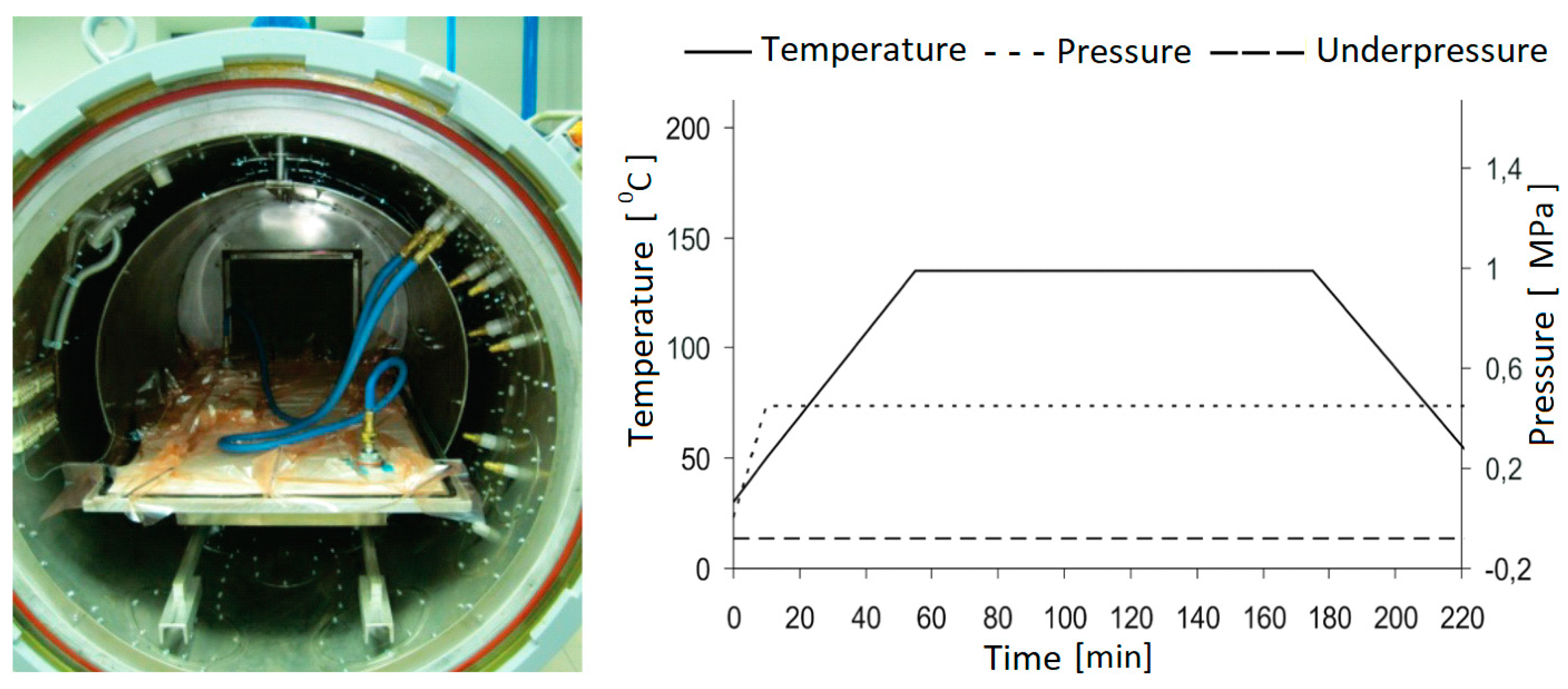
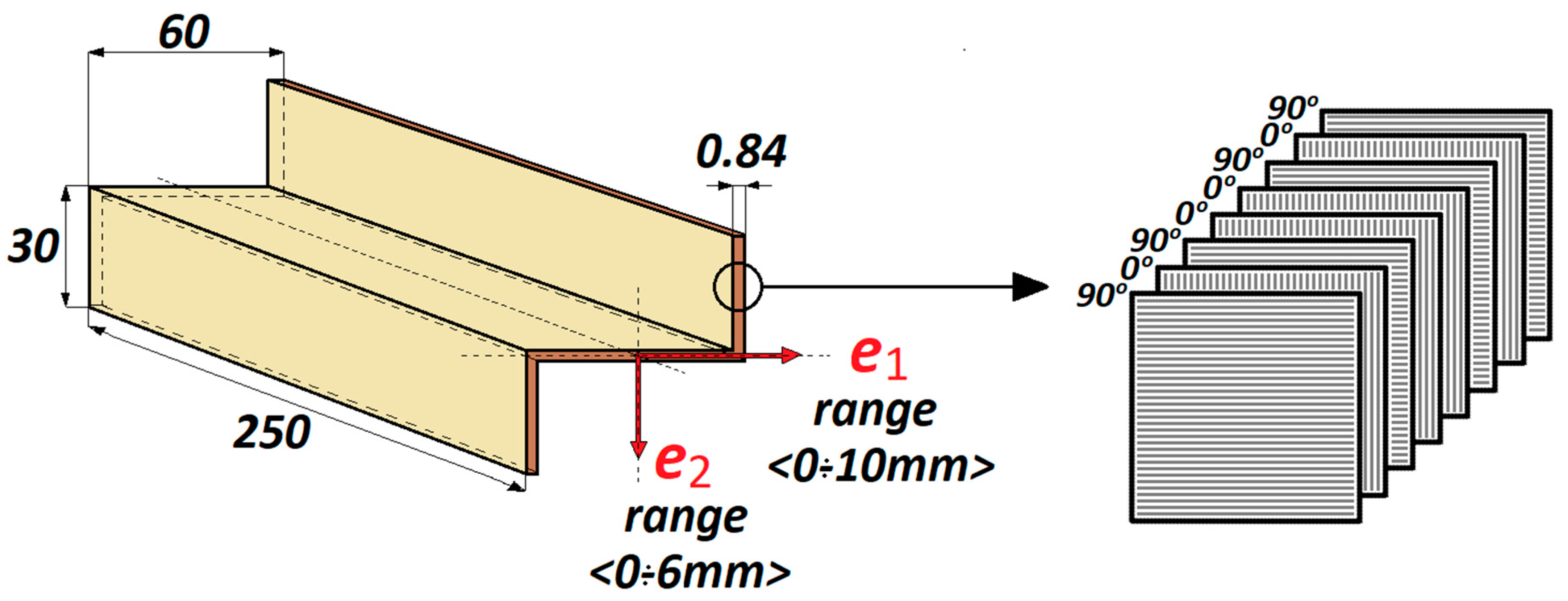
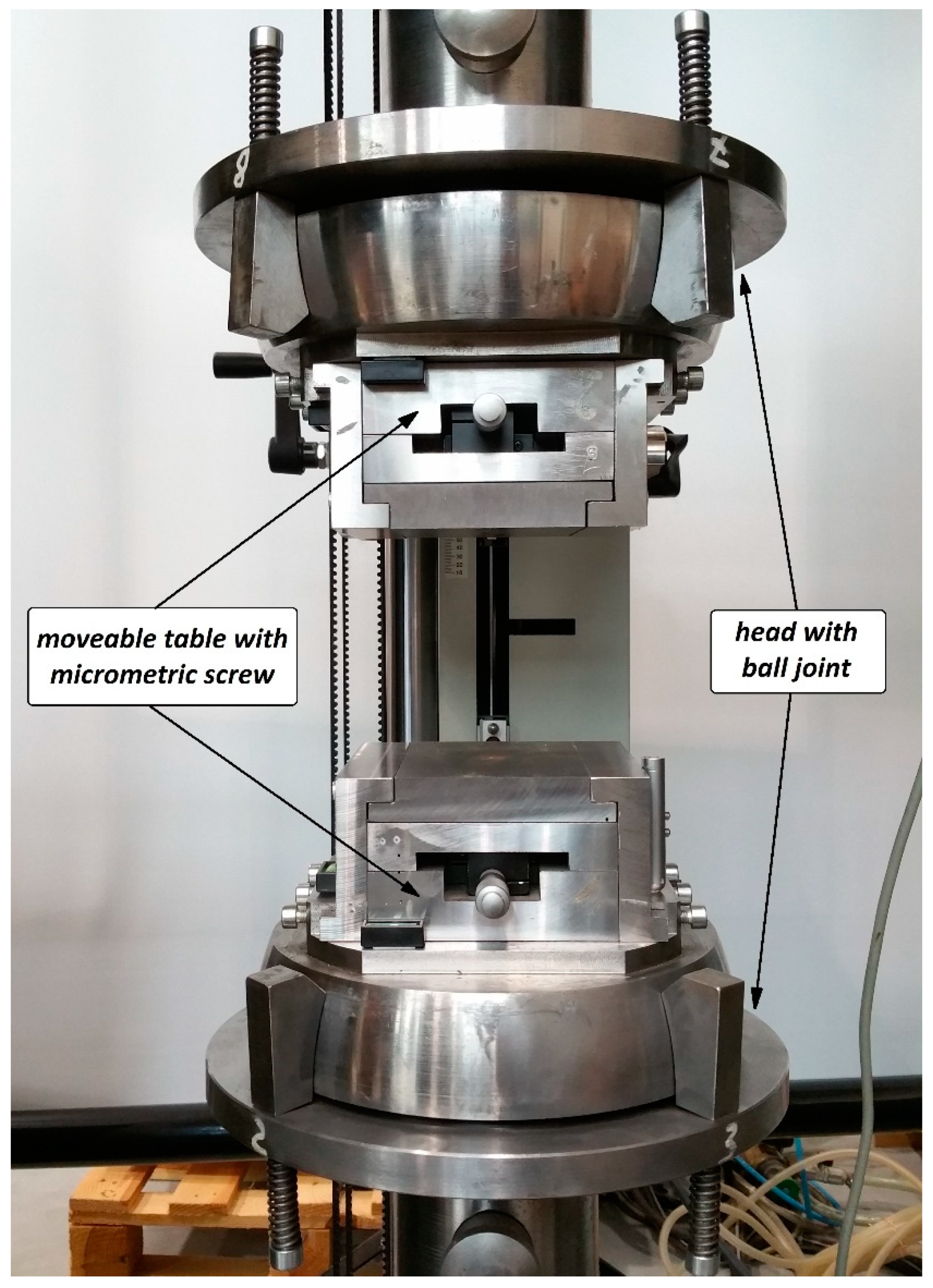
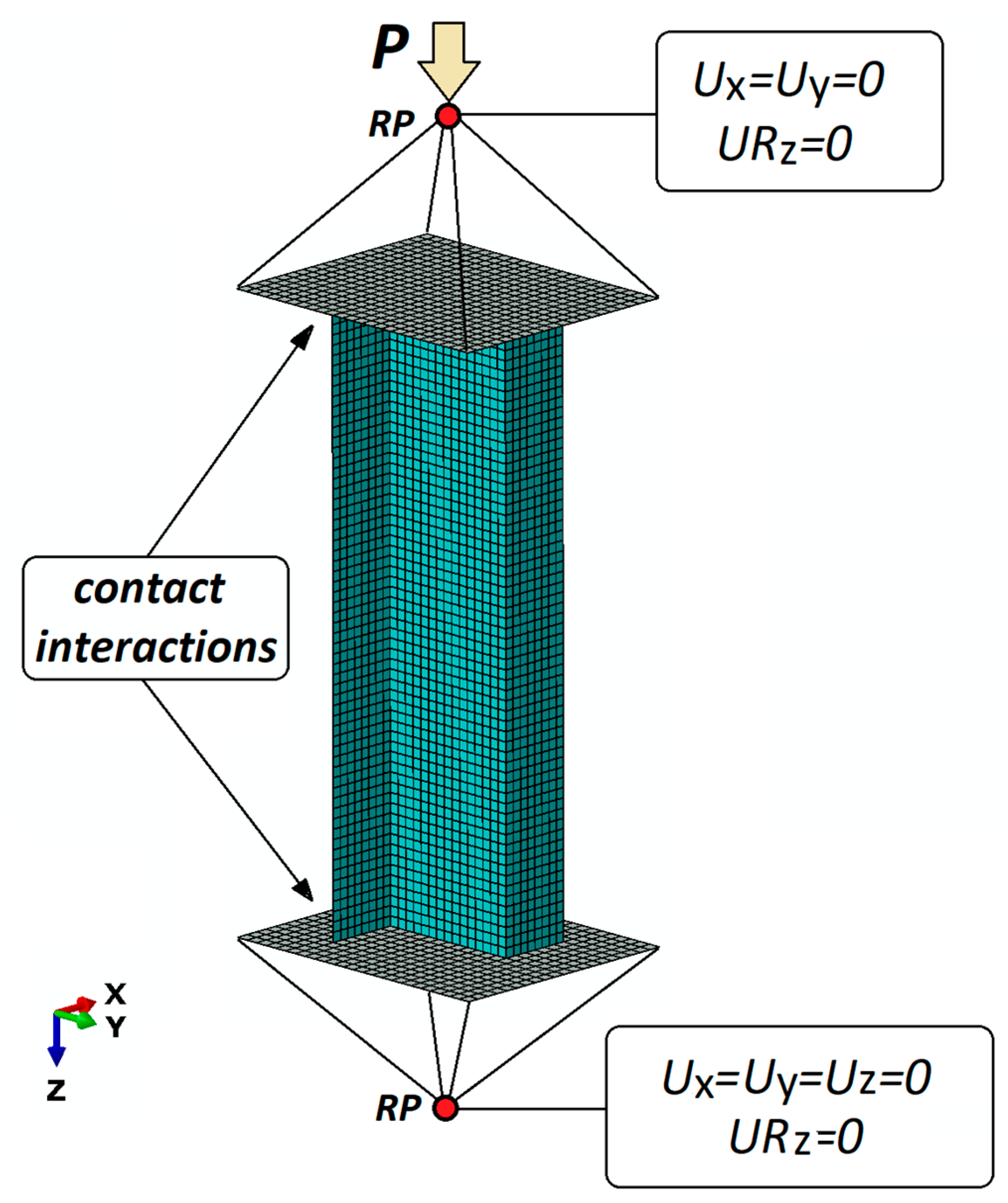
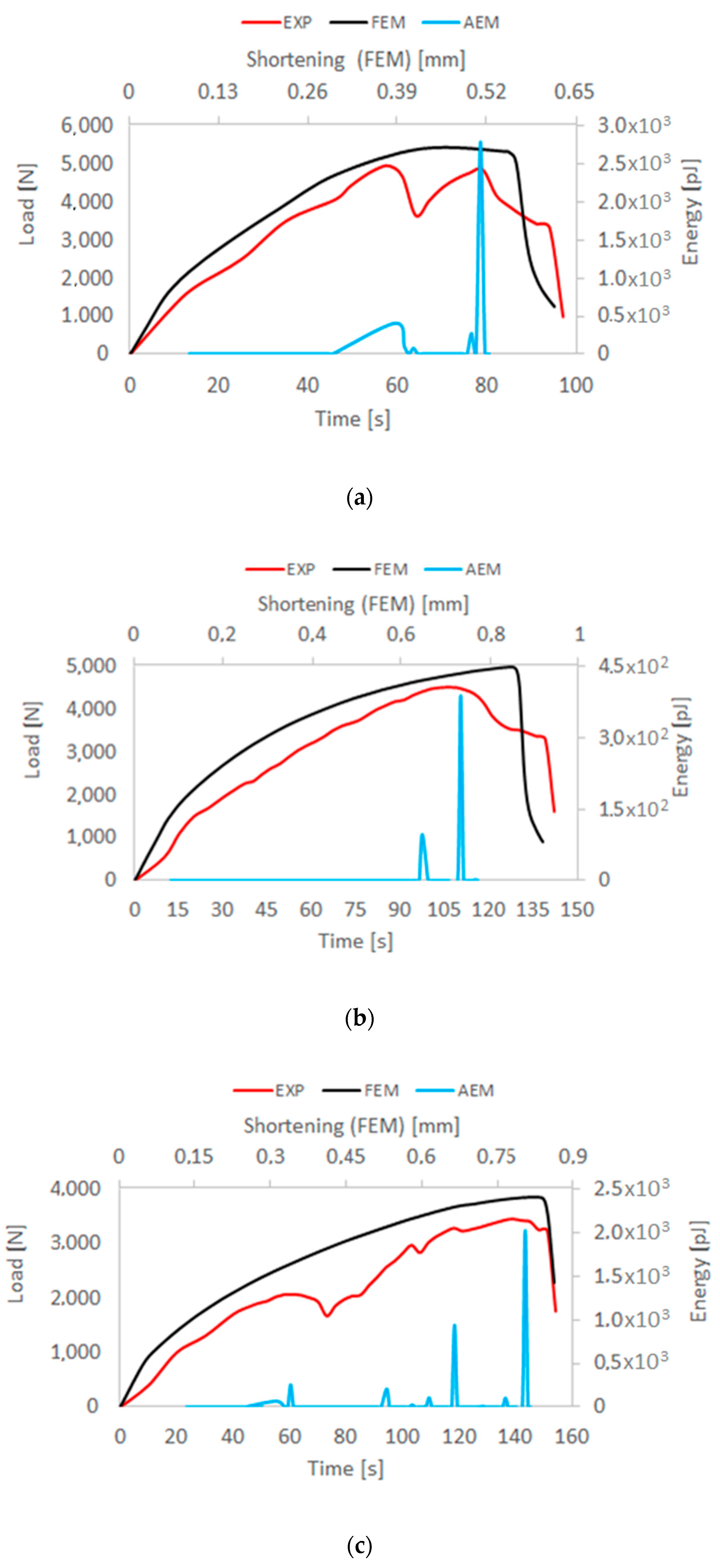

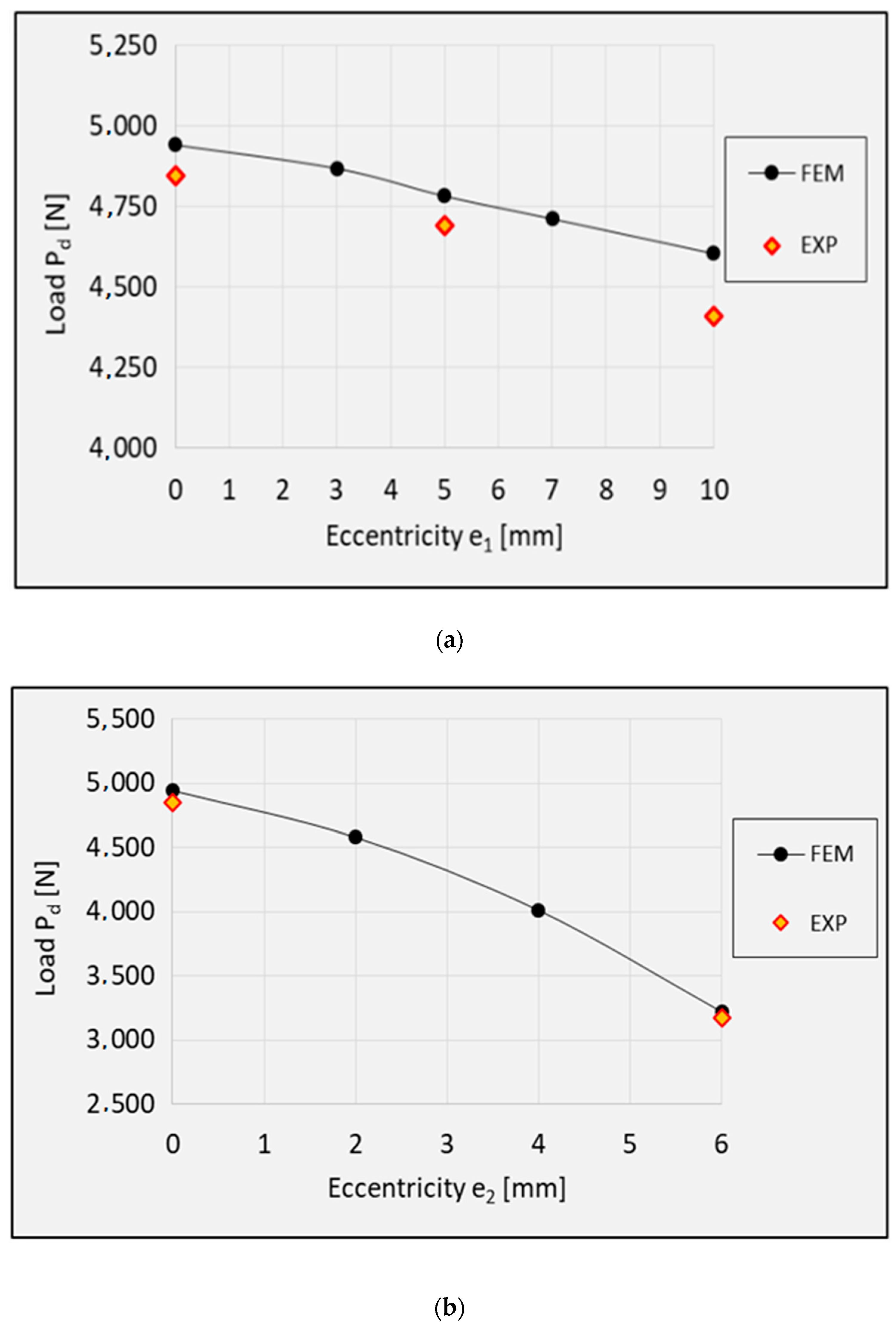
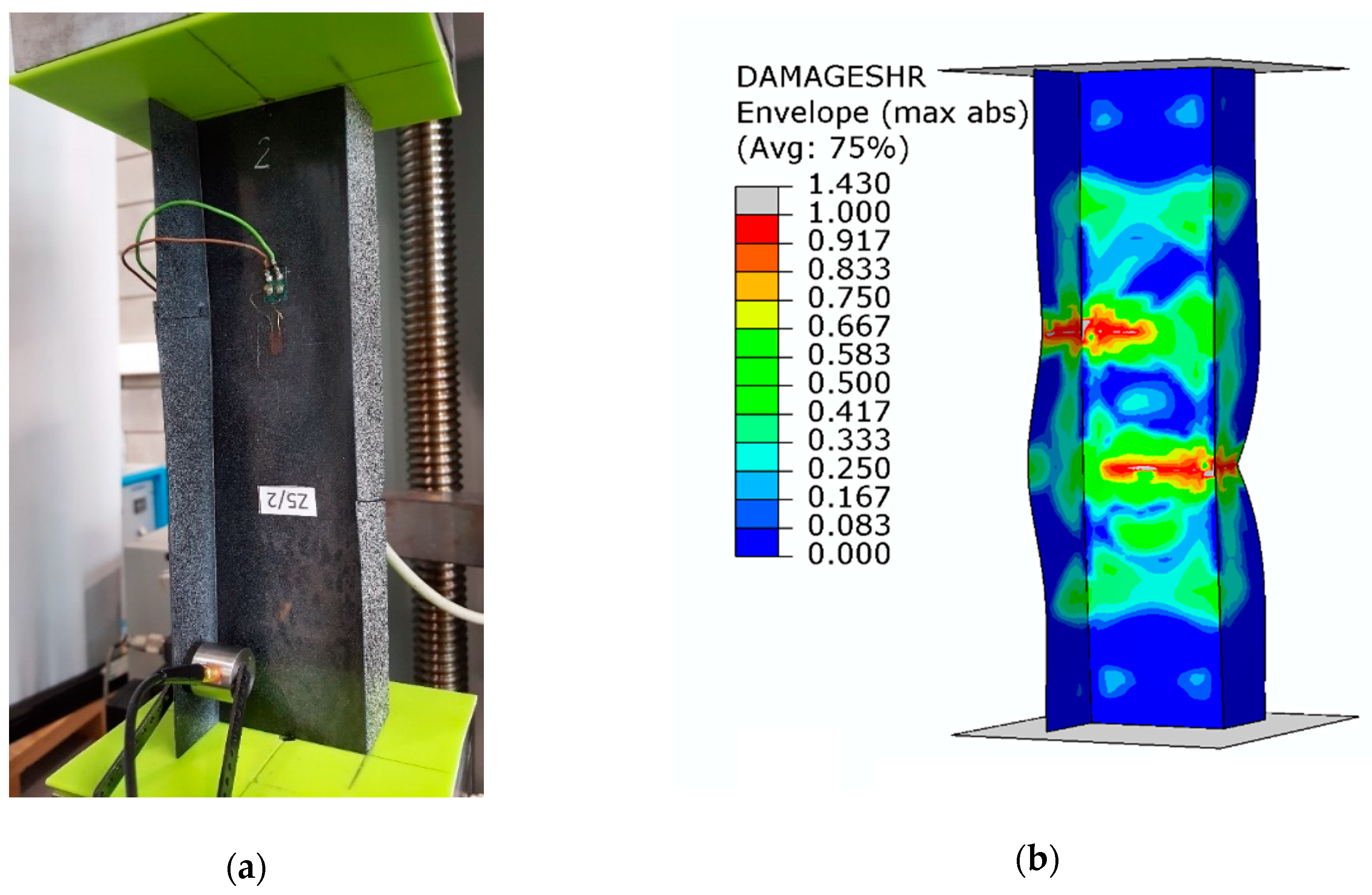
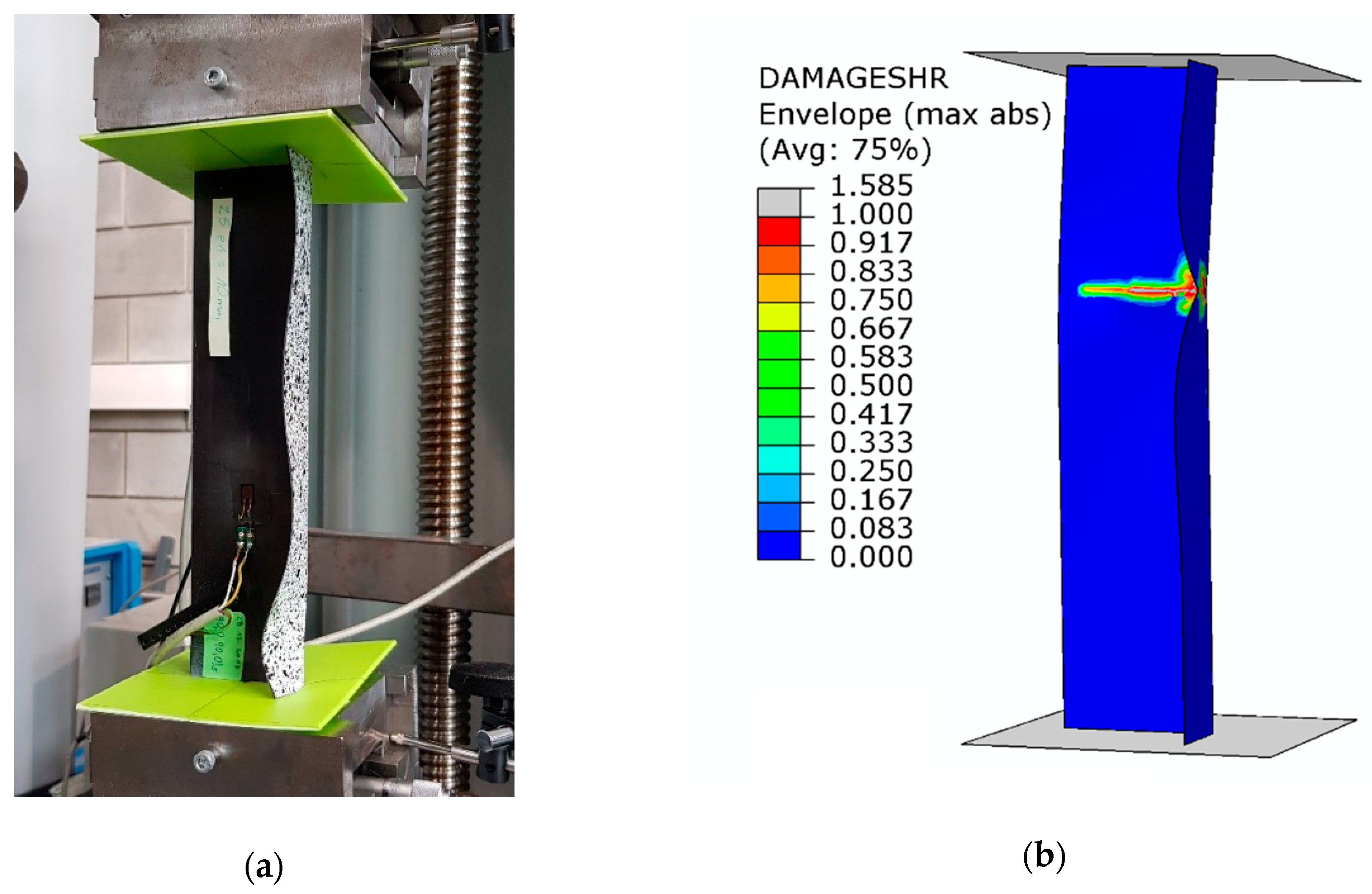
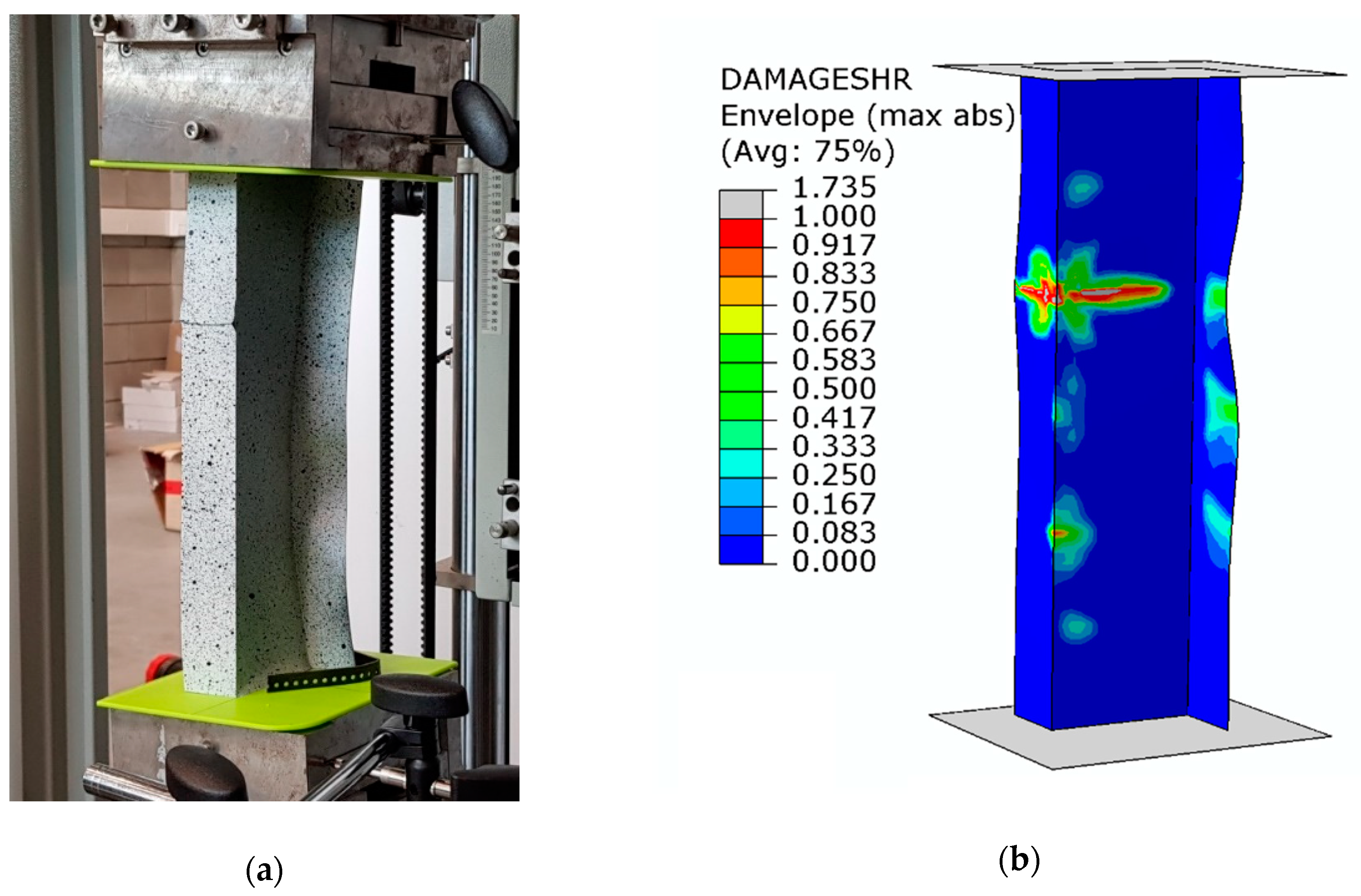
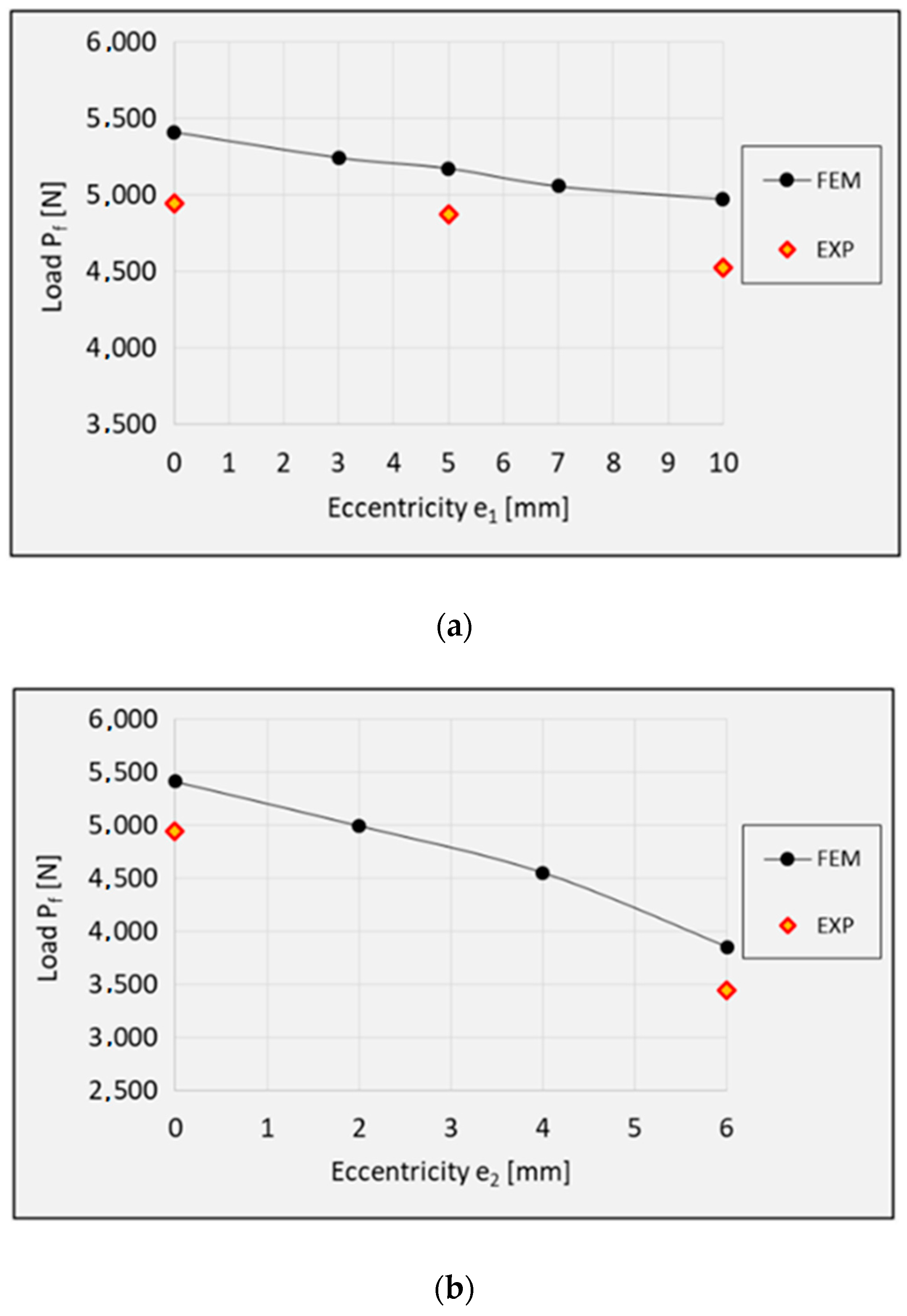
| Tensile Strength FTU [MPa] | Tensile Modulus ET [MPa] | Poisson’s Ratio ν12 | Shear Strength FSU [MPa] | Shear Modulus G [MPa] | Compression Strength FCU [MPa] | |||
|---|---|---|---|---|---|---|---|---|
| 0° | 90° | E1 (0°) | E2 (90°) | 0° | ±45° | ±45° | 0° | 90° |
| 2220.7 | 49 | 143,528.5 | 5826.3 | 0.36 | 83.5 | 3845.5 | 641 | 114 |
| Fracture energy G1t Fiber tension [N/mm] | Fracture energy G1c fiber comp. [N/mm] | Fracture energy G2t matrix crack. [N/mm] | Fracture energy G2c matrix crush. [N/mm] | Viscosity coefficients η1t, η1c, η2t, η2c [-] | ||||
| 133 | 10 | 0.5 | 1.6 | 0.0005 | ||||
| Eccentricity [mm] | Direction e1 | Direction e2 | |||||||
|---|---|---|---|---|---|---|---|---|---|
| 0 | 3 | 5 | 7 | 10 | 0 | 2 | 4 | 6 | |
| Numerical [N] | 4941 | 4867 | 4782 | 4711 | 4603 | 4941 | 4578 | 4010 | 3219 |
| Experimental [N] | 4847 | - | 4691 | - | 4408 | 4847 | - | - | 3172 |
| Difference [%] | 1.9 | - | 1.9 | - | 4.2 | 1.9 | - | - | 1.5 |
| Eccentricity [mm] | Direction e1 | Direction e2 | |||||||
|---|---|---|---|---|---|---|---|---|---|
| 0 | 3 | 5 | 7 | 10 | 0 | 2 | 4 | 6 | |
| Numerical [N] | 5408 | 5241 | 5171 | 5054 | 4969 | 5408 | 4992 | 4551 | 3852 |
| Experimental [N] | 4941 | - | 4872 | - | 4521 | 4941 | - | - | 3440 |
| Difference [%] | 8.6 | - | 5.7 | - | 9.0 | 8.6 | - | - | 10.7 |
© 2020 by the authors. Licensee MDPI, Basel, Switzerland. This article is an open access article distributed under the terms and conditions of the Creative Commons Attribution (CC BY) license (http://creativecommons.org/licenses/by/4.0/).
Share and Cite
Debski, H.; Samborski, S.; Rozylo, P.; Wysmulski, P. Stability and Load-Carrying Capacity of Thin-Walled FRP Composite Z-Profiles under Eccentric Compression. Materials 2020, 13, 2956. https://doi.org/10.3390/ma13132956
Debski H, Samborski S, Rozylo P, Wysmulski P. Stability and Load-Carrying Capacity of Thin-Walled FRP Composite Z-Profiles under Eccentric Compression. Materials. 2020; 13(13):2956. https://doi.org/10.3390/ma13132956
Chicago/Turabian StyleDebski, Hubert, Sylwester Samborski, Patryk Rozylo, and Pawel Wysmulski. 2020. "Stability and Load-Carrying Capacity of Thin-Walled FRP Composite Z-Profiles under Eccentric Compression" Materials 13, no. 13: 2956. https://doi.org/10.3390/ma13132956
APA StyleDebski, H., Samborski, S., Rozylo, P., & Wysmulski, P. (2020). Stability and Load-Carrying Capacity of Thin-Walled FRP Composite Z-Profiles under Eccentric Compression. Materials, 13(13), 2956. https://doi.org/10.3390/ma13132956








